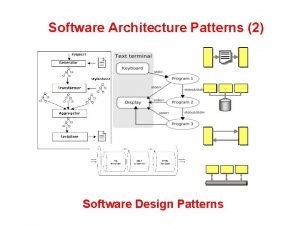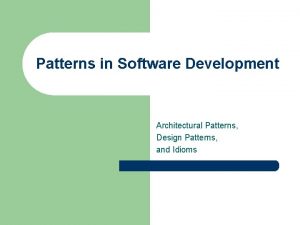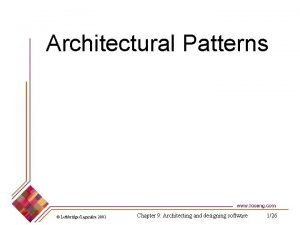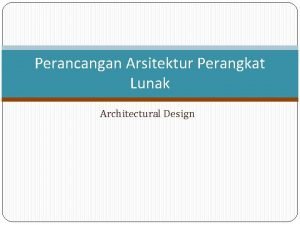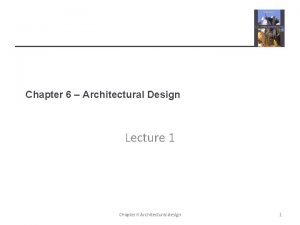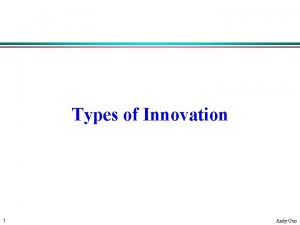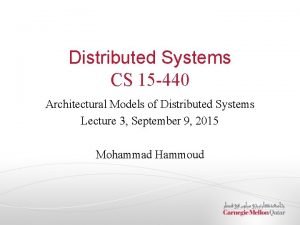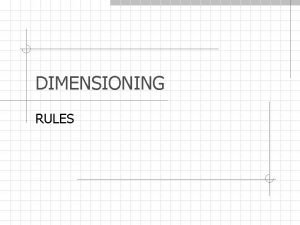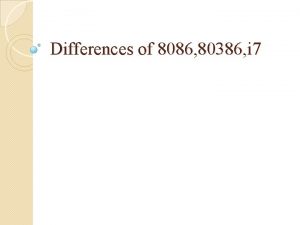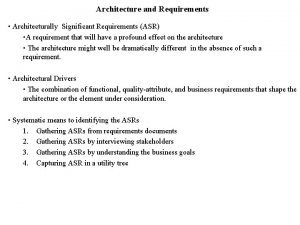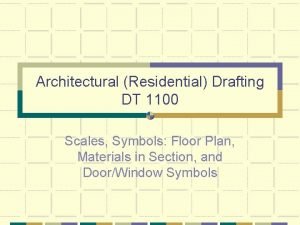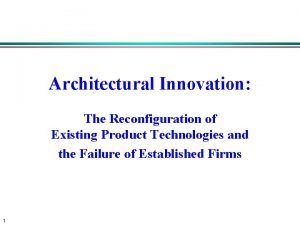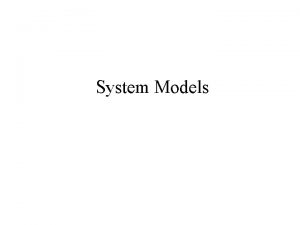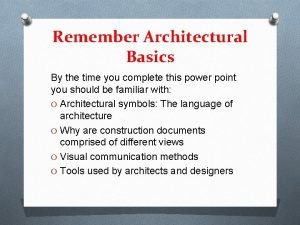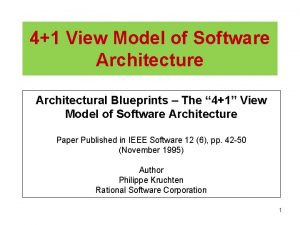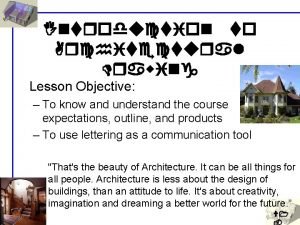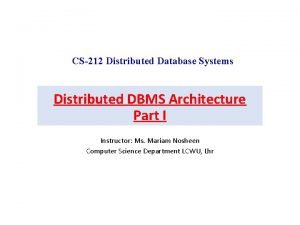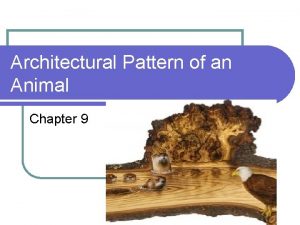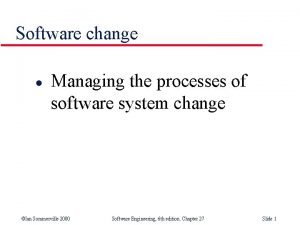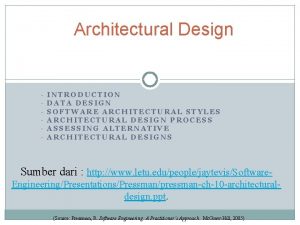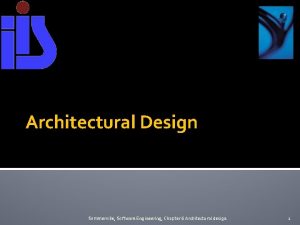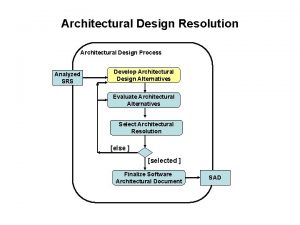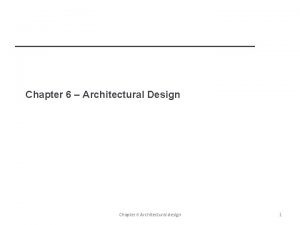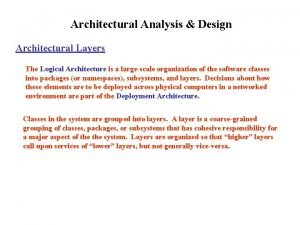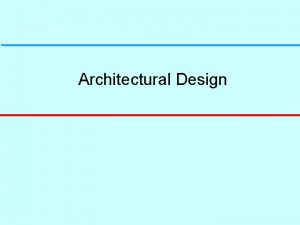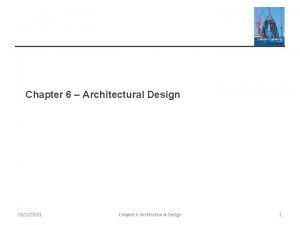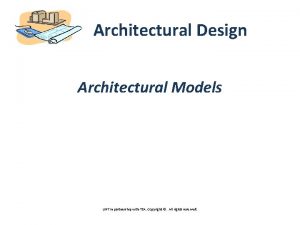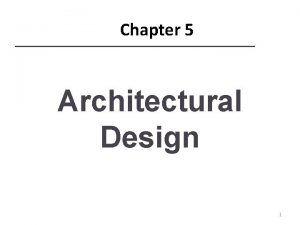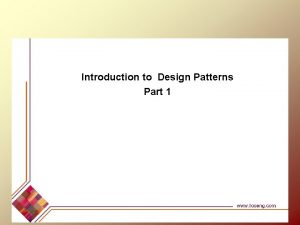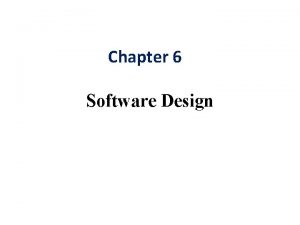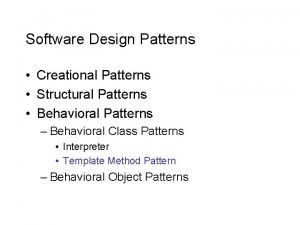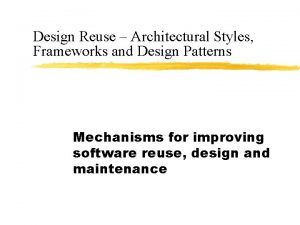Patterns in Software Development Architectural Patterns Design Patterns




























































- Slides: 60

Patterns in Software Development Architectural Patterns, Design Patterns, and Idioms

Introduction l l Patterns occur in ever facet of software development, at every phase, and at every level of detail The ability to recognize patterns allow us to classify problem solutions in terms of problems and contexts, providing a common vocabulary for software developers to use

What are Patterns? l Christopher Alexander says “Each pattern describes a problem which occurs over and over again in our environment, and then describes the core of the solution to that problem in such a way that you can use this solution a million times over, without ever doing it the same way twice”

Great, so what is a Pattern? l In general, a pattern has the following attributes: – – The Name: the pattern name is a handle we can use to refer to the pattern, thus describing the problem, solution, and consequences in a word or two The Problem: Describes when to apply the pattern, this is broken into both a description of the problem and its context. The Solution: describes the elements that make up the design, their relationships, responsibilities, collaborations. Often includes some example code or pseudo-code, but doesn’t describe a particular implementation The Consequences: describes the results and trade-offs of using the pattern. All design is compromise, and make patterns provide both benefits and drawbacks that must be balanced

The Need for Patterns l l Designing object-oriented software is hard Designing reusable object-oriented software is even harder – – Have to find pertinent objects, factor them into classes at the right granularity, establish relationships between them, design a flexible interface Design should be specific enough for the problem at hand, but general enough to address future problems (scale up or down)

Multiplicity of Design l l l The problem most inexperienced designers face isn’t that there aren’t any solutions to a problem, it’s that there are too many It’s hard to choose the proper solution from a large set of potential solutions without experience in what works and what doesn’t work for a given problem (results, consequences, and trade-offs are hard to foresee) Experienced designers know which solutions have worked in the past and which haven’t; they have experience in the consequences and trade-offs

Purpose of Patterns l The purpose of patterns then can be generalized as providing the following: – – – Giving a vocabulary to a problem, context, solution, consequences set Cataloging designs that have proved successful in past systems and formalizing their elements, relationships, interactions, etc. Provide enough information about trade-offs and consequences to allow an intelligent design decision to be made about applying a given solution

Types of Patterns l There are generally 3 types of patterns: – – – l Architectural Patterns Design Patterns Idioms Briefly cover Architectural Patterns, focus on Design Patterns, and discuss some Idioms (idioms tend to be language specific)

Architectural Patterns l l Architectural Patterns express a fundamental structural organization for software systems It provides a set of predefined sub-systems, specifies their responsibilities, and includes rules for establishing relationships between them

Architectural Patterns Examples l l l 3 -tier database systems (Database, Intermediate DB Layer, User-Application) Client/Server Component (Module) -Based Software Systems Feedback Systems Event-Driven Systems

Design Patterns l l Popularized by the 1995 book Design Patterns: Elements of Reusable Object-Oriented Software written by Erich Gamma, Richard Helm, Ralph Johnson, and John Vlissides (also called the Gang of Four Book or GOF) Their work largely based on Alexander’s The Timeless Way of Building

How Design Patterns Solve Problems l l l OOP is made up of objects, where an object packages both data and operations that may be performed on that data Ideally, the only way to change the data of an object is via a request to that object (normally a method call) – we call this encapsulation; it’s representation is invisible to the outside world The hard part of object-oriented design is decomposing a system into objects. Many factors come into play: granularity, encapsulation, dependency, flexibility, performance, reusability, and each affects the nature of the decomposition, often in conflicting ways

Object-Oriented Design Paradigms l OO Design methodologies favor many paradigms for designing object-oriented systems: – – – l You can single out objects and “verbs” in your system and write corresponding classes and operations Focus on collaborations and responsibilities in the system (have objects for different sub-systems) Model the “real-world” and draw object design from their real world counterparts Object-Oriented design also tends to foster a “meet in the middle” style of design; where you first decompose a system into high-level abstractions, usually objects, and then design reusable primitives that allow you to build those high level systems

Object Granularity l l l Objects can very tremendously in size and scope, from directly interfacing with low-level hardware all the way up to the application level Deciding what should be an object is an important task Too often classes are designed poorly and, instead of encapsulating a single concept or abstraction, end up as the anti-pattern “the blob”. The blob tends to grow well beyond modeling a single concept or encapsulating a single entity, it violates the “one-object, one-responsibility” notion of OOP

The Blob *the failure of the do-it-all interface l l l An Anti-Pattern that is often used to describe classes that encompass many concepts and abstractions Usually a large behemoth class with little or no encapsulation The problem with large, behemoth classes is that they tend to widen the gap between what is syntactically valid and what is semantically valid in a system. That is, you end up with constructs that are syntactically correct, but violate the semantics of the program. – In general, if X must be done in a system before Y, the structure of your code and design should enforce this constraint as much as possilble

Types and Interfaces l l A type is a name used to describe a particular interface (this does not necessarily have to refer to a concrete class) Objects declare a set of operations that it supports, each of these operations has a particular signature, that is, it’s name, the objects it takes as parameters and its return type. The set of all operations that an object supports defines an interface to that object – Nothing is said of member functions, etc. In C++ and other languages, free-functions can also be considered part of an objects interface if they define a valid operation on a given object

Inheritance vs. Composition l l There are two common techniques for facilitating object reuse in systems: class inheritance and object composition. Object composition refers to assembling (composing) multiple objects together to get more complex functionality Each has their own advantages and disadvantages, but in general, one of the tenets of object-oriented programming is to Favor object composition over class inheritence

Why Composition is Better l l l Usually, inheritance is defined at compile-time, meaning you can’t change implementations inherited from parent classes at run-time Parents classes usually define at least part of their subclasses’ physical representation. For this reason, it’s often said that “inheritance breaks encapsulation”. Normally, the subclass is implemented in terms of the parent’s implementation, leading to a cascade of changes should a parent class be modified Composition is defined at run-time by objects acquiring references to other objects. Composition requires objects to respect interfaces, which require objects to be designed so they don’t stop you from using an object with many others

More on Composition l l Because objects are accessed solely through their interfaces, we do not break encapsulation, and any object may be swapped out for another so long as their type (that is, their interface) remains the same Composition also allows for each class to be kept isolated, small, and well encapsulated. Inheritance hierarchies will tend to remain small and will be less likely to grow into unmanageable and unmaintainable monsters

Back to Patterns l l l Axiom: Patterns help to facilitate good design by defining good object granularities, interfaces, responsibilities, relationships, and abstractions Patterns are not solutions to new problems, they are solutions to established and studied problems that crop up again and again in object-oriented systems Patterns are not specific to any code, language, or implementation, they describe general solutions to problems

Categories of Design Patterns l Design Patterns are generally broken into three groups: – – – Creational Patterns deal with object creation at run-time Structural Patterns deal with the composition of objects and classes Behavioral Patterns deal with the way in which classes or objects interact and distribute responsibility

Design Pattern Catalog Creational Patterns Behavioral Patterns Abstract Factory Builder Factory Method Prototype Singleton Chain of Responsibility Command Interpreter Iterator Mediator Memento Multiple Dispatch Observer State Strategy Template Method Visitor Structural Patterns Adapter Bridge Composite Container Decorator Façade Flyweight Proxy

Patterns Explored l l l We’ll explore a small subset of the given patterns in detail, going over the concept, the problem/context pair, solution, and a little about implementation Attempt to focus on patterns that aren’t obvious or common sense Patterns to explore – – Factory Method Composite Iterator Visitor

Factory Method l Intent – l Problem – – l Define an interface for creating an object, but let subclasses decide which class to instantiate. Factory Method lets a class defer instantiation to subclasses Frameworks use abstract classes to define and maintain relationships between objects. A framework is also often responsible for creating these objects Sometimes it is impossible at compile-time to determine which objects need instantiated. The framework knows when an object is needed, but not what kind Applicability – – You have a certain family of objects that are all inter-related, but each entity in the family performs a different task You cannot determine at compile-time which object to instantiate, and the object that’s to be created may change at run-time

Factory Method l Participants – Product l – Concrete. Product l – Implements the product interface, defines a concrete type Creator l – Defines the interface of objects the factory method creates Declares the factory method, which returns an object of type Product Concrete. Creator l Provides a concrete factory method that returns an instance of a Concrete. Product

Factory Method

Motivating Example l l l You’re designing an application that supports opening of many different types of documents, for the sake of an example, let’s say a program like Photoshop, so you can open. png, . jpg, . gif, etc. At some level of granularity, you need to create different objects to handle these different types of documents, it could be at a high-level, defining a different Document class for each type of file, or at a low-level, defining a different Doc. Reader class for each file You don’t know at compile-time what kinds of files are going to be open, and what’s more, the types of files supported by the system might expand in the future

An Implementation This example uses C++ and templates to create a generic Factory template <class Key, class Product, class Creator = Product* (*)() > class Factory { public: void Register(const Key& id, Creator creator); Product Create(const Key& id); private: std: : map<Key, Creator> creators_; };

Implementation l The Factory classes used templates to achieve generality. In the case of our example, let’s see how it would be used: struct Doc. Reader. Creator { Document. Reader* operator ()(); }; class Factory<string, Document. Reader, Doc. Reader. Creator*> factory; struct JPGReader. Creator : public Doc. Reader. Creator { JPGReader* operator ()() {return new JPGReader(); } };

Implementation factory. Register(“JPG”, new JPGReader. Creator); // Sometime later, a request to open a document is given: Doc. Reader* reader = factory. Create(reader_type); l When a reader is created, there are no details visible about the type of reader created other than an identifier that signifies the object type, which in our case is just a string. This allows new products to easily be added to the factory, and avoids using a giant switch to determine what kind of object to create

Composite l Intent – l Problem – – l Compose objects into tree structures to represent part-whole hierarchies. Composite lets clients treat individual objects and compositions of objects uniformly You want to build more complex components out of simpler components, combining them together at run-time to create complex objects However, you don’t want to treat the objects and their containers differently; manipulation should be uniform across all related objects Applicability – Use when you want clients to be able to ignore the difference between compositions of objects and individual objects. Clients will treat all objects in the composite structure uniformly

Composite l Participants – Component l l – Leaf l l – Declares the interface for objects in the composition Implements default behavior for the interface common to all classes, as appropriate Represents leaf objects in the composition Defines primitives in the system Composite l l Defines behavior for components having children Stores children components

Composite

Composite l Consequences – – Defines class hierarchies consisting of primitives and compositions uniformly; wherever a client expects a primitive object, it can also take a composition Makes the client simple, as the client can treat composite structures and single objects uniformly Makes it easy to add new kinds of components Disadvantage is that it can make your design overly general; it’s harder to restrict the components of a composite, often have to rely on run-time rather than compile-time checks to enforce contraints

Motivating Example l l Compilers are used to generate abstract syntax trees of languages so analysis can be performed and code generated But, part of an AST should be treated uniformly, consider expressions: – – l Each expression can be made up of multiple expressions, but we should be able to treat all expressions uniformly Expressions could be made up of algebraic operators, variable accesses, etc We’d like to treat all expressions in a uniform manner for when we later need manipulate the syntax tree

Implementation struct Expression { virtual int evaluate() = 0; }; class Plus : public Expression { public: Plus(Expression* lhs, Expression* rhs); int evaluate() {return lhs. evaluate() + rhs. evaluate(); } };

Implementation class Identifier { public: int evaluate() {return val_lookup(id); private: string id; }; struct Int. Literal { public: Int. Literal(int n); int evaluate() {return val; } };

Implementation // Usage, for expression 10 + 5 + a Expression* e = new Plus(new Int. Literal(10), new Plus(new Int. Literal(5), new Identifier(“a”));

Iterator l Intent – l Provide a means to access the elements of an aggregate type without exposing its underlying implementation Problem – – – An aggregate object such as a list should give a means to iterate across all elements in the list without exposing its internal structure But, you don’t want to clutter the list interface with messy details about traversals, particularly if it precludes you from having multiple traversals occurring at once You might also want to be able to swap the list container out with a different container later on, but keep the code that uses the container the same

Iterator l Applicability – – – l Use an iterator to access an aggregate object’s contents without exposing its underlying implementation To support multiple traversals of a aggregate objects To decouple an aggregate object from the algorithms that act upon that object The last point is significant, and provides the motivation for our example

Iterator l Participants – Iterator l – Concrete. Iterator l – Particular iterator implementation Aggregate l – defines an interface for accessing and traversing elements defines an interface for creating an iterator object Concrete. Aggregate l creates concrete iterators

Motivating Example l l l We’d like to design a set of containers, iterators, and algorithms that can all work together to provide a library of data structures The algorithms should, whenever possible, be decoupled from the containers they operate on. This allows us to define new algorithms that work with existing containers, and new containers that work with existing algorithms Fortunately for us, if we’re using C++, this problem has already been solved

C++ Iterators l l The concept of iterators is very important to the C++ Standard Library. They provide an abstraction between the representation of data stored in containers, and the algorithms that act upon that data Sample: Say we have a function, print, that we want to use to print the contents of a container. We’d like to generalize this algorithm as much as possible, hopefully so we can use it for multiple containers. template <class Fwd. Iterator> void print(Fwd. Iterator begin, Fwd. Iterator end) { while (begin != end) { std: : cout << *begin << std: : endl; ++begin; } }

C++ Iterators l Again, we use C++ templates to generalize the function. Our type, Fwd. Iterator, is an iterator concept, that is, it provides the operations increment (++), and dereference (*). In this way, Iterators form a subset of pointer syntax and semantics. The type of iterator passed to print is inconsequential, so long as it supports the iterator concept: std: : vector<int> v; // assume v is later populated print(v. begin(), v. end()); // print v int array[20]; // assume array is populated print (array, array+20); // pass in two pointers std: : list<int> l; // asume l is populated print (l. begin(), l. end()); // print l

Visitor l Intent – l Represent an operation to be performed on the elements of an object structure. Visitor lets you define a new operation without changing the classes of the elements on which it operates Motivation – – Sub-classing allows us to easily add new class types, and these new classes can define different behavior for a family of objects However, it is relatively hard to add new operations to a given set of classes; the new operation must be added to each class in the hierarchy. Distributing all of these new operations across all the classes also makes the classes harder to understand is frequently undersirable

Visitor l Applicability Use visitor when: – An object structure contains many classes of objects with differing interfaces and you want to perform operations on these objects depending on their concrete class types – Many distinct, unrelated operations need to be performed on objects and you want to avoid polluting the classes with these operations. Visitor lets you keep related operations together – The class hierarchy is relatively stable, that is, classes are rarely added or removed from the existing class hierarchy, but you often want to add new operations, Changing the hierarchy requires changing the interfaces to all the visitors

Visitor l Participants – Visitor l – Concrete. Visitor l – Declares an Accept method that takes a visitor as an argument Concreate. Element l – Defines each Visit method for a particular operation; a Concrete. Visitor defines a single operation to be performed on the class hierarchy Element l – Declares a Visit method for each class in the object hierarchy that you want to be visitable Implements the Accept method Object Structure l Can enumerate it’s elements, may provide a way to apply a visitor over a range of elements, such as over a list

Visitor

Motivating Example l l l Back to our example about a compiler and building abstractsyntax trees In general, the class hierarchy of an abstract syntax tree doesn’t change much once it has been defined, unless a language change is made, in which case, a lot of things need to be rewritten anyway However, we frequently want to perform many different, unrelated operations on a syntax tree, such as type checking, program restructuring, code generation, interpreting, etc

Implementation abstract public class ASTNode { public void Accept(Visitor vis); } public class Plus. Node { public void Accept(Visitor vis) { vis. Visit(lhs); vis. Visit(rhs); vis. Visit(this); } }

Implementation public class Visitor { public void Visit(Plus. Node plus); public void Visit(Int. Literal int. Literal); public void Visit(Id. Node id); } public class Interpreter { public void Visit(Plus. Node plus) { stack. push (stack. pop() + stack. pop()); } public void Visit(Int. Literal i) { stack. push(i. value()); } }

Visitor l l l The primary disadvantage of visitor is that it’s difficult to add new classes in the future, you need to be sure your class hierarchy is relatively stable and that a change to it represents a major change to the system The visitor pattern roughly implements a notion known as double dispatch; that is, instead of dynamically dispatching on a single type, such as in Java or C++ (the object type determines the function that is called), double dispatch uses two types to determine which function to call This is NOT function overloading; function overloading takes place entirely at compile-time, double dispatch takes place at run-time

Discussion l l Patterns do not exist as isolated elements of a system, frequently patterns work together to achieve design goals. We’ve already seen how composite can be used in conjunction with Visitor for class hierarchies. The Command pattern, which encapsulates a request in the system as an argument for delayed evaluation, can frequently be used with the Factory Method pattern; Commands are created at run-time by a Factory depending on user action

Idioms l l Idioms are lower level patterns than general design patterns; they are often specific to a programming language, and usually only encompass a few lines of code Idioms however are important to understand, and it’s often crucial to pick up the particular idioms of a language to use it properly

Scope. Guard l Intent – l Scope guard is a pattern that occurs in languages with deterministic destruction designed to facilitate an undo operation, particularly in the case of exceptions being thrown Motivation – – Writing exception safe code is hard, particularly when you want to enforce certain exception guarantees The usual exception handling techniques, namely try…catch doesn’t scale particularly well, and clutters code with additional control flow statements

Scope. Guard l Example: – Consider the following function void Compound. Operation() { Complex. Operation 1(); Complex. Operation 2(); } l Assume that both Complex. Operation 1 and Complex. Operation 2 might throw an exception. Also assume that we want this function to give the strong exception guarantee; that is, either all of its operations succeed, or any changes made are rolled back in the face of failure

Scope. Guard l First approach might be this: void Compound. Operation() { Complex. Operation 1(); try { Complex. Operation 2(); } catch (exception e) { Undo. Op 1(); throw; } } l This works, but now our 2 line function has become 6 or 7 lines, what’s more, the control flow is interrupted by try…catch blocks that don’t add any semantic meaning to the normal control flow, they’re only there in case of errors

Scope. Guard l l What’s more, this solution doesn’t scale well. Consider what happens if we have 3 operations instead of 2; now we’re faced with the prospect of nested try…catch blocks, all to handle an exception that should rarely occur; the resulting function spends more code dealing with error handling than actual program semantics We need a way to alleviate the burden of writing all the try…. catch blocks that still allows us to write exception safe code, in this case, undoing the first operation should the second fail

Scope. Guard l Scope. Guard’s Task – Encapsulate an undo request in an object such that, should an exception be thrown, the guard will perform the undo operation void Compound. Operation() { Complex. Operation 1(); Scope. Guard guard(&Undo. Op 1); Complex. Operation 2(); guard. dismiss(); } l This seems much nicer than our previous solution. We’ve added 2 lines of code, yes, but they are less intrusive than the try catch blocks. What’s more, this solution scales well, if we have 3 operations, we can simply add another guard that performs the undo of the second operation.

Design Patterns Questions?
 Design patterns in architecture
Design patterns in architecture Architectural patterns in software engineering
Architectural patterns in software engineering Architectural design in software engineering
Architectural design in software engineering Architectural styles and patterns
Architectural styles and patterns Broker pattern
Broker pattern Architectural pattern in software engineering
Architectural pattern in software engineering Software architecture diagram
Software architecture diagram Contoh desain arsitektur perangkat lunak
Contoh desain arsitektur perangkat lunak Architectural design
Architectural design Architectural design in huddersfield
Architectural design in huddersfield Example of design objectives in architecture
Example of design objectives in architecture Sequence diagram of airline reservation system
Sequence diagram of airline reservation system Architectural design workflow
Architectural design workflow What is a design pattern in software engineering
What is a design pattern in software engineering Real time software design in software engineering
Real time software design in software engineering Design principles in software engineering
Design principles in software engineering Dimensioning floor plans
Dimensioning floor plans Modular innovation examples
Modular innovation examples Blackboard architecture style example
Blackboard architecture style example What is batch sequential style
What is batch sequential style Architectural risk analysis
Architectural risk analysis Pkix architectural model
Pkix architectural model Natural ventilation examples
Natural ventilation examples Cigital's architectural risk analysis process
Cigital's architectural risk analysis process Iot conceptual and architectural framework,
Iot conceptual and architectural framework, Reading architectural drawings
Reading architectural drawings Architectural model of distributed system
Architectural model of distributed system Dimensioning rules
Dimensioning rules Features of 80386 microprocessor
Features of 80386 microprocessor Triploblasts
Triploblasts Floor plan key symbols
Floor plan key symbols Struts architecture
Struts architecture Asr utility tree
Asr utility tree Glass window symbol floor plan
Glass window symbol floor plan Architectural evolution
Architectural evolution Architectural innovation
Architectural innovation Roman architectural achievements
Roman architectural achievements Fireplace architectural symbol
Fireplace architectural symbol Architectural engineering penn state
Architectural engineering penn state Service ade 9500 systems
Service ade 9500 systems Common architectural scales
Common architectural scales Architectural basics
Architectural basics Architectural technology sheridan
Architectural technology sheridan Internetworking architecture model
Internetworking architecture model Brickwork symbol in drawing
Brickwork symbol in drawing An architectural blueprint for autonomic computing
An architectural blueprint for autonomic computing Architectural finishing systems
Architectural finishing systems Architectural hand lettering
Architectural hand lettering 4+1 architectural view model
4+1 architectural view model Types of architectural drawings
Types of architectural drawings Introduction to architectural drawing
Introduction to architectural drawing Which is not a architecture of distributed database
Which is not a architecture of distributed database An example of a distributed database is
An example of a distributed database is Architectural pattern of an animal
Architectural pattern of an animal Architectural roof features
Architectural roof features Architectural drawing layout
Architectural drawing layout Architectural lettering
Architectural lettering Talon haa
Talon haa South african council for the architectural profession
South african council for the architectural profession Architectural evolution
Architectural evolution Key distribution center
Key distribution center
